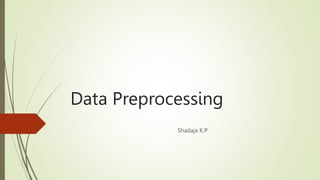The document discusses data mining as a crucial step in the knowledge discovery process, involving data cleaning, integration, selection, transformation, mining, pattern evaluation, and knowledge presentation. It emphasizes the importance of data preprocessing to improve the quality of data and mining results, including techniques for handling noise, missing values, and inconsistencies in real-world datasets. Additionally, the document outlines methods for data reduction and transformation to optimize the data mining process effectively.

















![ In numerosity reduction, the data are replaced by alternative, smaller representations
using parametric models (e.g., regression or log-linear models) or nonparametric models
(e.g., histograms, clusters, sampling, or data aggregation).
Data mining methods provide better results if the data to be analyzed have been
normalized, that is, scaled to a smaller range such as [0.0, 1.0].
Discretization and concept hierarchy generation can also be useful, where raw data values
for attributes are replaced by ranges or higher conceptual levels.
For example, raw values for age may be replaced by higher-level concepts, such as youth,
adult, or senior.
Discretization and concept hierarchy generation are powerful tools for data mining in that
they allow data mining at multiple abstraction levels.
Normalization, data discretization, and concept hierarchy generation are forms of data
transformation.
3/9/2024
18](https://image.slidesharecdn.com/chapter2-ml-240309055545-5f2923f8/85/Machine-learning-topics-machine-learning-algorithm-into-three-main-parts-18-320.jpg)
















































































![ Data Transformation by Normalization
The measurement unit used can affect the data analysis.
For example, changing measurement units from meters to inches for height, or from
kilograms to pounds for weight, may lead to very different results.
In general, expressing an attribute in smaller units will lead to a larger range for that
attribute, and thus tend to give such an attribute greater effect or “weight.”
To help avoid dependence on the choice of measurement units, the data should be
normalized or standardized.
This involves transforming the data to fall within a smaller or common range such as
[−1,1] or [0.0, 1.0].
Normalizing the data attempts to give all attributes an equal weight.
3/9/2024
99](https://image.slidesharecdn.com/chapter2-ml-240309055545-5f2923f8/85/Machine-learning-topics-machine-learning-algorithm-into-three-main-parts-99-320.jpg)

![ Min-max normalization maps a value, vi, of A to v′i in the range [new_minA, new_ maxA]
by computing
Min-max normalization preserves the relationships among the original data values.
It will encounter an “out-of-bounds” error if a future input case for normalization falls
outside of the original data range for A.
3/9/2024
101](https://image.slidesharecdn.com/chapter2-ml-240309055545-5f2923f8/85/Machine-learning-topics-machine-learning-algorithm-into-three-main-parts-101-320.jpg)















